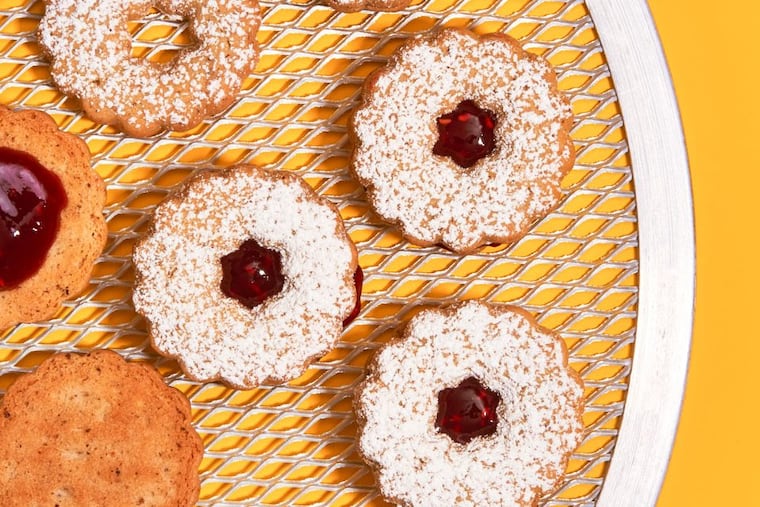The story of the Linzer cookie, American style
These cookies are also a year-round staple at some of Philly's most enduring German bakeries, but they actually originated in Austria and have been adapted for American tastes.

Rare is the Christmas cookie swap that doesn't include linzer cookies, their raspberry jam peeping through a hole in their two layers of warmly spiced, nut-filled dough like stained glass in a church on Christmas Eve.
These cookies are also a year-round staple at some of Philly's most enduring German bakeries: Holmesburg and Lipkin's, both in the Northeast, and Bredenbeck's in Chestnut Hill, which leads me to assume this was a German treat.
That is, until I visited Linz, Austria, and ran into dozens of linzer tortes, the granddaddy of these cookies and Linz's proudest achievement.
Compared to fairy tale Saltzburg and elegant Vienna that it's sandwiched between, Linz is a stark, charmless industrial city, with the unfortunate distinction of having been the favorite metropolis of Adolf Hitler.
Linzer torte detractors might detect some of Linz's grimness in its signature sweet: a sturdy, sometimes dry, giant lattice-topped jam-and-nut tart.
Smitten Kitchen blogger Deb Perelman, on the other hand, says this torte's "aromatic blend of walnuts, cinnamon, cloves and lemon zest" epitomizes Christmas.
These opposing reactions could have to do with Americans' and Europeans' "whole different approach" to desserts, says pastry chef Jessica Nolen of Brauhaus Schmitz and Whetstone Tavern. "We're like, 'How much caramel can we put on that?' Europeans let the taste of the ingredients shine through." She calls the linzer torte "a classy, mature-type dessert," and a perfectly beautiful and impressive thing to take to a party.
Another reason some moderns might not immediately take to this torte: It dates to 1653, making it the world's oldest cake. Linz was on an Adriatic trade route that was the source of the torte's spices and lemon. Kaffeehaus dessert cookbook author Rick Rodgers says the nutty crust was used because, historically, "nuts were free and a lot more available than wheat."
Virtually all the bakeries in Linz sell Linzer tortes, as whole rounds, slices, or squares. The linzer torte is also a popular home dessert, hence the many variations in spices, nuts, and fruit used in recipes (although red currant — plentiful in Upper Austria — is the default jam there).
The linzer torte is also a popular holiday treat in neighboring Germany, Hungary, Italy, and Switzerland (where it spawned the linzerlike spitzbuben — "little rascals" — cookie).
The linzer cookie — sometimes called linzer augens after its peek-a-boo jam "eye" — if not invented in America, as sometimes claimed, was at least widely popularized here. It's by far the most common way the linzer dessert appears in Greater Philadelphia bakeries. It's the best-selling cookie year-round at the bakery annex of the Austrian-rooted Dining Car restaurant, says owner/manager Nancy Morozin. There, the shape of the cookie's eye changes seasonally from the usual circle to a star at Christmas and a heart for Valentine's Day.
Bredenbeck's Bakery also makes linzer cookies daily and actual tortes by special order in December. Owner Karen Boyd-Rohde says that the raspberry preserve, hazelnut, and almond ingredients are expensive and that even the comparatively easy cookie requires multiple steps. (For example, she has to sprinkle on the powdered sugar before putting the two cookies together — otherwise "the sugar gets on the jam and makes it cloudy.") The nutty dough is also famously fussy.
One way to dodge the difficulties of rolling out that dough is to simply press it into the pan, as Nolen did to make linzer bars at the late French bistro Coquette. "I've also seen people just throw pieces of broken-off dough onto the jam as an easy way to create that second pastry layer," she says.
Using hazelnut or almond flour is another recommended time-saver. (Bob's Red Mill is one readily available brand.)
To make her simplified version of the "little rascals" bakery cookie she loved as a child, Dorie's Cookies author Dorie Greenspan rolls her dough out immediately after blending walnuts, flour, and cold butter together in a food processor, thus skipping the standard instruction to let the dough rest in the refrigerator. Beyond walnuts and jam, her only flavorings are cinnamon and lemon.
The latter, she says, adds an "unexpected, really nice ping to the warm butter and nut flavors." The texture is "crumbly and gritty in the best way. And they're beautiful. They're like little magnets — people can't help but be drawn to them."
Like wise men drawn to a star in bleak midwinter.
Like a dessert that redeemed a cold city for me.